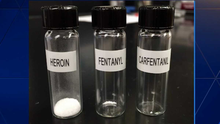Summary

NIST is measuring the trace chemical signatures and quantities of trace residues and background levels that contaminate surfaces associated with the concealment of illicit drug materials including fentanyl and its analogs. Current efforts include: documenting a swiping protocol for sampling packages and the surrounding area for optimized collection of trace illicit drug residues, identifying background contamination present on seized packages and those exposed to the stream of commerce and assess its impact on IMS performance and the ability to identify suspect packages.
Description
“Method for evaluating ion mobility spectrometers for trace detection of fentanyl and fentanyl-related substances”, Jennifer R Verkouteren, Jeffrey Lawrence, R Michael Verkouteren and Edward Sisco, Analytical Methods, 11(47), 6043-6052 (2019).
“Discriminative potential of ion mobility spectrometry for the detection of fentanyl and fentanyl analogues relative to confounding environmental interferents”, TP Forbes, J Lawrence, JR Verkouteren and R. Verkoutern, Analyst, 144 (21), 6391-6403 (2019).
“Separation and Detection of Trace Fentanyl from Complex Mixtures Using Gradient Elution Moving Boundary Electrophoresis”, ST Krauss, D Ross and TP Forbes, Analytical chemistry, 91(20), 13014-13021 (2019).
“Rapid detection of fentanyl, fentanyl analogues, and opioids for on-site or laboratory based drug seizure screening using thermal desorption DART-MS and ion mobility spectrometry”, E Sisco, J Verkouteren, J Staymates and J Lawrence, Forensic chemistry 4, 108-115 (2017).

